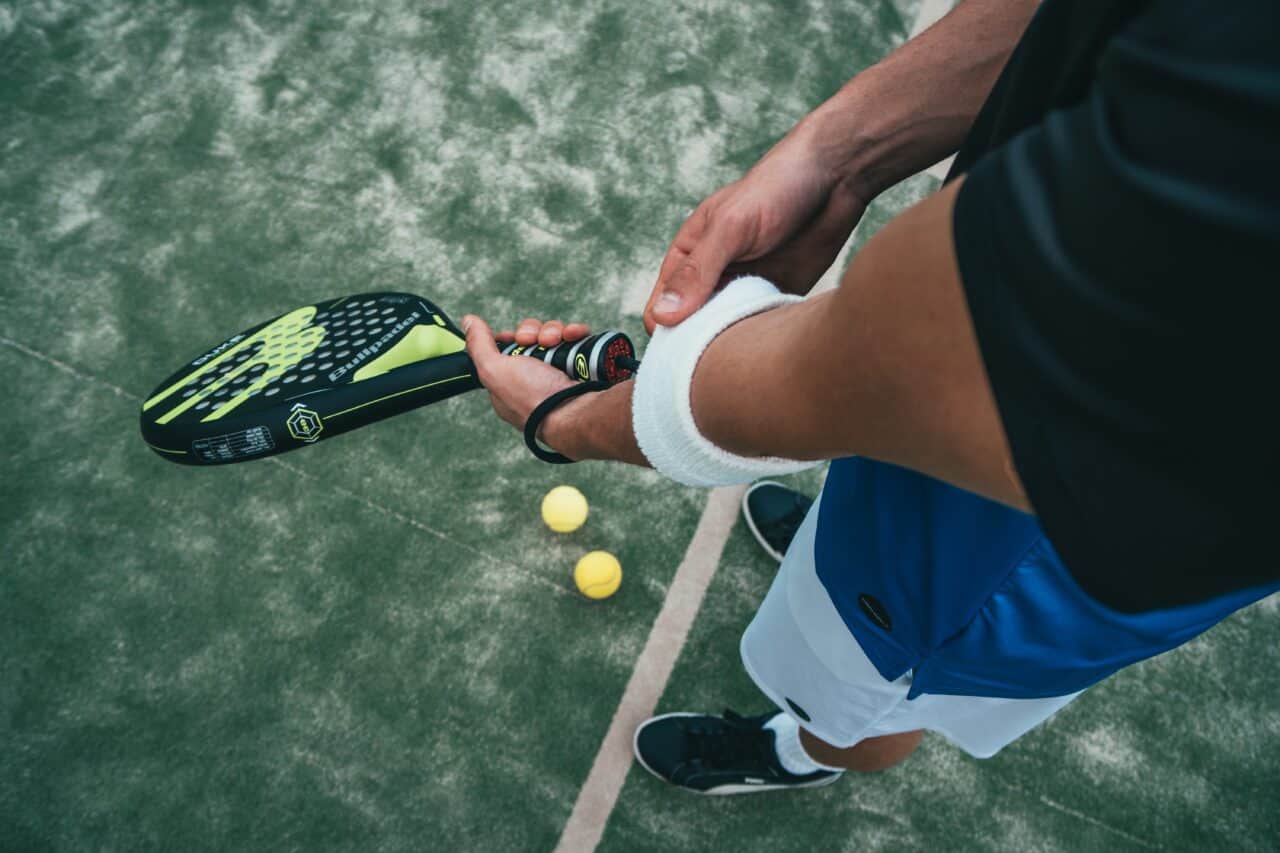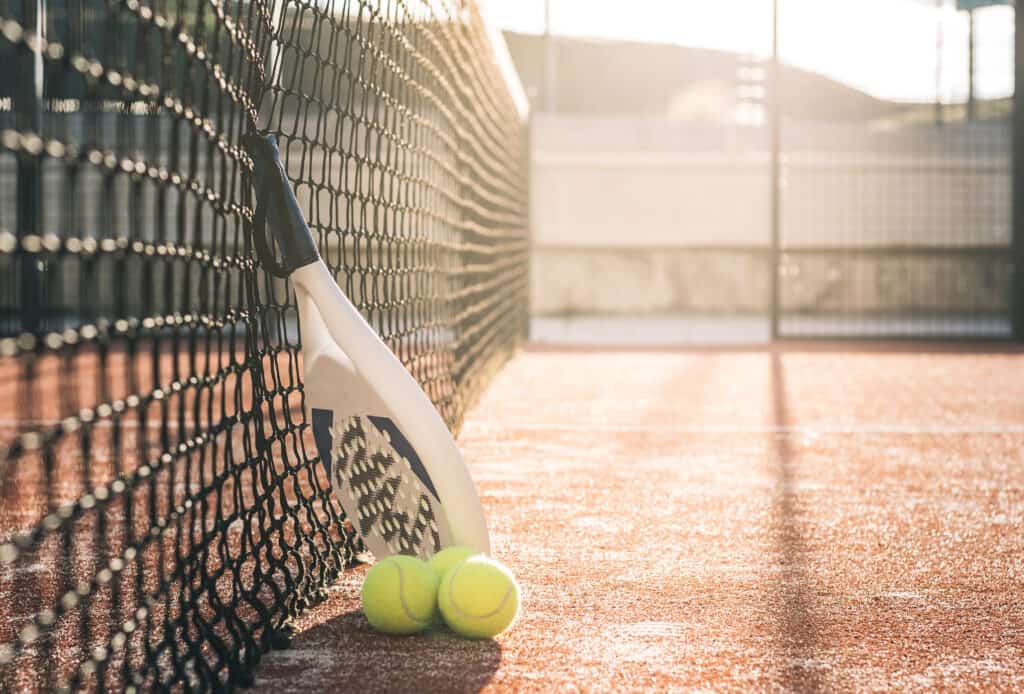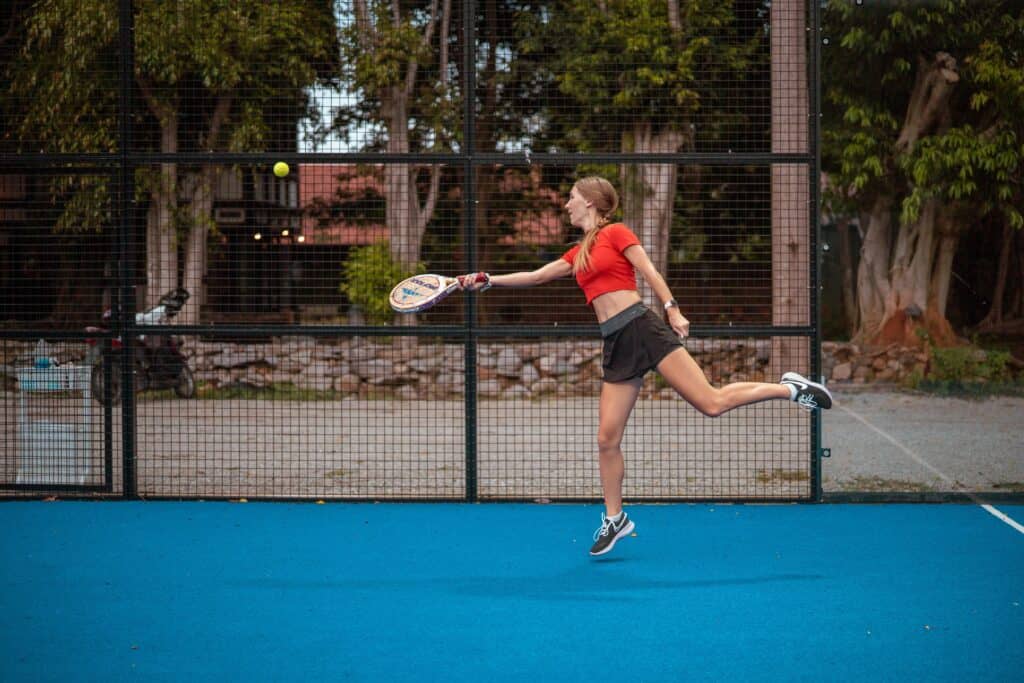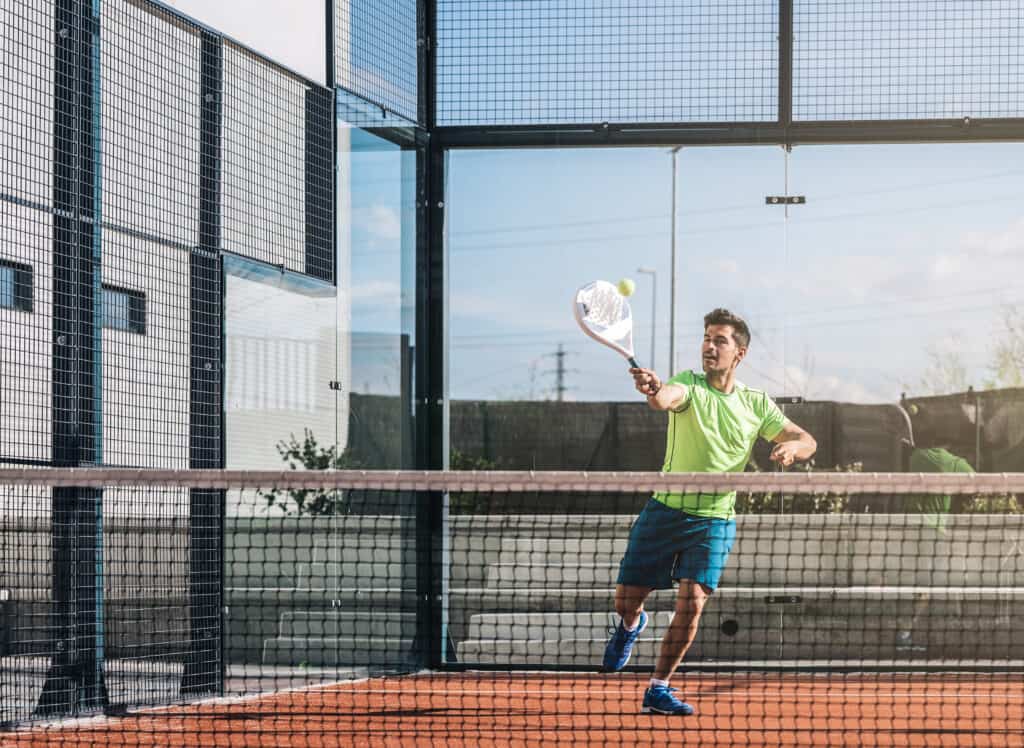
Padel for beginners: Tips, fundamentals, and first steps
Imagine discovering a sport tailored specifically for newcomers – a gentle initiation into the world of racket games. That’s exactly what the trendy sport of Padel offers. Padel, also referred to as Padel Tennis, blends aspects from both tennis and squash, resulting in a distinct and dynamic playing experience. In this article, we’ll introduce you to the sport’s basics, and explain why it’s an ideal choice for beginners. We’ll also share some practical advice to help you start off successfully.
The basics of Padel for beginners: Rules and gameplay mechanics

Before stepping onto the Padel court, it’s crucial to grasp the foundational aspects and rules of Padel – from court layout to executing serves and returns.
Court and court structure: A Padel court is smaller than a tennis court and enclosed by glass walls. The court takes on a rectangular shape, divided down the middle by a net. The court’s dimensions are roughly 10 meters wide and 20 meters long. The presence of walls allows players to bounce the ball off them, introducing a distinctive dynamic to the game.
Serves and returns: The game commences with the serve, where the ball is sent over the net to the opponent’s side in an underhand motion. The ball must first land on the server’s side and then clear the net. Returns follow similar rules to tennis, with the added element that the ball can rebound off the walls, creating tactical opportunities.
Scoring: Padel employs a scoring system akin to tennis. A game is composed of points, games, and sets. The sequence of scoring is 15, 30, 40, and then game. A set usually consists of playing up to six games, with a lead of at least two games required to clinch the set.
Doubles play and positioning: Padel is predominantly a doubles game, emphasizing social interaction and strategic positioning. Players adjust their positions according to the game’s dynamics, striving to place the ball where opponents have difficulty reaching.
Technique and movement: The fundamental shots in Padel include forehand and backhand, much like tennis. Maintaining a relaxed wrist motion is essential for controlled ball contact. Navigating the court demands agility and strategic placement to effectively engage with the ball while ensuring optimal court coverage.
The right equipment for Padel beginners: Paddle racket and ball

Selecting suitable equipment is pivotal for a successful entry into the Padel game. As a beginner, you won’t need much initially. Simply borrow Paddle rackets and Padel balls from your local Padel club, along with three of your sporty pals, and you’re ready to roll. For starters, pay special attention to picking the appropriate Paddle racket. A racket that complements your playing style can make a substantial difference, helping you tap into your full potential. Moreover, donning comfortable attire and appropriate footwear is crucial, granting you the necessary freedom of movement and support.
11 tips for beginners: Your first steps in Padel

Getting started in the world of Padel sports can be both exciting and a bit of a challenge. To help you navigate this new territory, we’re here to introduce you to some fundamental techniques and strokes that will really make a difference for beginners. From finding the right stance to nailing your shots, we’ll walk you through step by step on how to improve your game.
1. Join beginner classes: Kick off your Padel journey by enrolling in entry-level Padel classes at your local club. Here, you’ll learn the game’s basics, techniques, and rules from experienced coaches who will set you up with a solid foundation.
2. Choose the right paddle racket: It’s important to pick a paddle racket that suits your playing style and fits your hand comfortably. Going for a racket with a good balance and a grip that feels right will make your learning curve smoother.
3. Understand the basic rules: Get acquainted with the essentials of Padel, like how the court is set up and how serves and returns work. This will make your playtime much smoother and more enjoyable right from the start.
4. Work on your technique: Focus on core shot techniques such as forehand and backhand. Start with simple drills that can help improve your hand-eye coordination and refine your strokes.
5. Master your positioning: Learning where to stand on the court to make the best shots and set yourself up for returns is a key aspect of Padel.
6. Use the walls strategically: Padel Tennis offers a unique twist—you can use the walls to your advantage. Discover how to bounce the ball off the walls for tactical benefits.
7. Communication in doubles: If you’re teaming up for doubles, effective communication with your partner is essential. Clear coordination on shots, positioning, and strategies can truly level up your game.
8. Patience and consistency: While Padel offers an accessible entry point, it’s also a sport that demands technique. Don’t expect instant perfection. Regular practice, patience, and allowing yourself to make mistakes as you improve are all part of the journey.
9. Gain playing experience: The more you play, the more comfortable you’ll become in various in-game scenarios. Teaming up with different partners can expose you to a variety of playing styles.
10. Embrace the fun and social side: Enjoy the social aspects of Padel. Play with friends or colleagues and connect with new players. The sheer enjoyment of the game and the simple pleasure of moving are essential parts of a successful start.
11. Prioritize safety: Make sure to wear appropriate sportswear and shoes to avoid any potential injuries. Executing movements and techniques correctly will also help prevent overexertion and injuries.
9 things to know about serving in Padel Tennis

As a beginner in Padel, getting a handle on your serve is a key focus. Here are some key points to keep in mind:
1. Serving position: Stand in the back right corner of your serving box (diagonally opposite your opponent). Have your body turned sideways to the net, and hold the ball in your non-dominant hand.
2. Ball placement: Hold the ball at hip height in your non-dominant hand. Aim for a spot between your body and the net.
3. Racket grip: Hold the Paddle racket with both hands at a medium height. Your hands should grip the racket handle around shoulder level.
4. Movement and stroke technique: Move slightly back and then forward as you make your serve. Start your swing with a gentle forward motion of your racket as you release the ball.
5. Ball toss: Toss the ball upward and a bit forward, placing it in a comfortable position for your serve. The toss shouldn’t be too high, as Padel-Tennis serves are underhand.
6. Execution: Perform an underhand serve by gently lifting the ball from below and striking it diagonally from underneath to clear the net. Make sure your Paddle racket makes contact with the ball on its way up.
7. Placement and speed: Aim to place the ball in your opponent’s serving box. A controlled serve that lands deep in the box can make it tougher for your opponents to make powerful returns.
8. After the serve: As soon as you’ve served, move to your optimal court position. Be ready to anticipate and respond to your opponents’ returns.
9. Play with strategy: Mix up the placement and speed of your serves to keep your opponents on their toes and use your tactical advantage.
Remember, serving in Padel Tennis is a vital strategic element. With consistent practice and a focus on technique, you’ll quickly see improvement in your serving skills.
The 9 most common mistakes for beginners in Padel

Just like in any sport, making errors on the Padel court is completely normal. However, knowing about these common mistakes can actually help you progress faster – whether it’s perfecting your shot technique or improving your positioning on the court.
1. Using too much power: Initially, it’s common to swing too hard in an attempt to generate more power. But this often results in uncontrolled shots and mistakes. Instead, focus on the technique and control of your shots. Technique matters more than sheer power.
2. Lack of communication in doubles: As mentioned earlier, clear communication with your doubles partner is crucial. When there’s a lack of coordination regarding positions, shots, and tactics, it can lead to confusion and inefficient play.
3. Excessive movement: In the beginning, there’s a tendency to move around the court excessively, which can lead to poor positioning and unnecessary fatigue. Learn to move strategically and take up the right positions.
4. Ignoring the walls: Walls are a vital aspect of Padel play. Beginners sometimes overlook the opportunity to use wall rebounds to their advantage for tactical gains.
5. Wrong racket choice: Picking the right Padel racket is key. A racket that doesn’t match your playing style can lead to technical issues. It’s best to seek advice from experts to find the perfect racket for you.
6. Insufficient focus on positioning: Proper court positioning matters. Initially, you might struggle to find the optimal position, resulting in subpar shots and gameplay situations.
7. Neglecting opponents: Pay attention to the movements and preferences of your opponents. Understanding their patterns allows you to react better and capitalize on tactical advantages.
8. Overwhelm with strategies: Having too many tactical considerations can be overwhelming. Beginners should initially concentrate on the basics and gradually integrate tactical elements into their game.
9. Lack of enjoyment: The fun factor is crucial in Padel. If you’re too fixated on errors or perfection, you might lose the joy of the game. Embrace the challenge and social interaction on the court.
8 simple Padel exercises for beginners: Technique and fitness

To refine your Padel technique and boost your physical condition, targeted exercises are crucial. In this section, we’ll introduce you to a selection of straightforward Padel exercises aimed at improving your technique while enhancing your fitness.
Practicing forehand and backhand shots
Stand at the baseline while a partner sends balls to your forehand and backhand sides. Work on hitting the ball at the center of the Padel racket, focusing on a relaxed wrist motion. Concentrate on controlled shots over the net.
Wall bounce exercise
Position yourself near the side wall of the Padel court. Have your partner hit the ball against the opposite wall, and it will bounce back to you. Try to hit the ball at the right moment to send it back towards the wall. This exercise sharpens your hand-eye coordination and timing.
Doubles positioning drill
Play with a partner on half of the Padel court. Practice moving and positioning correctly on the court to place the ball optimally. Make sure you’re not standing too close to each other and execute the right shots.
Ball bucket exercise
Use a ball bucket to consistently hit balls to a specific spot on the court. Alternate between forehand and backhand shots, working on your precision. This exercise helps refine your shot technique and ball control.
Serving practice
Practice serving from various positions in your service box. Focus on consistent ball placement and attempt to position the ball in a way that challenges your opponent’s return.
Running and hitting drill
Have your sports buddy hit balls to different areas of the court. Purposefully run to each ball and practice hitting while on the move. This improves your mobility and ability to execute shots in diverse situations.
Ball retrieval exercise
Stand at the net while your partner hits balls from a distance toward you. Practice defending against hard shots and receiving the ball at different heights. This exercise enhances your responsiveness and ability to return balls.
Five-Shot rally
Engage in a five-shot rally with your sports buddy, hitting the ball back and forth. The goal is to have a longer ball exchange exercise to enhance your endurance and ball control.
Differences Between Padel and tennis

Tennis and Padel are both racket sports played on a court with nets and rackets. While they share some similarities, there are also distinct differences between the two sports.
Court size and walls: One significant difference is the size of the court. A Padel court is smaller than a tennis court. Additionally, Padel courts have glass walls that are integrated into the game, allowing the ball to bounce off the walls.
Rackets: The rackets used in tennis and Padel are different. Padel rackets have holes and are shorter than tennis rackets. Padel rackets have a unique shape that enables the ball to bounce off the walls.
Serving style: In tennis, serves are typically executed from above, while in Padel Tennis, the serve is performed underhand. Padel also allows the use of glass walls to play tactical shots.
Doubles play: While doubles play exists in both sports, it is much more common and strategically important in Padel. The walls in Padel Tennis require specific positioning and communication strategies.
Ball bounce and speed: Padel balls are generally slower and have a lower bounce than tennis balls. This is due to the court dimensions and the game rules.
Shot technique: Padel requires special shot techniques due to the presence of glass walls, allowing players to make the ball bounce off the walls at different angles.
Duration of a game: Padel games are often shorter than tennis games, as the court is smaller and points can be played out more quickly.
Padel clubs and beginner classes: How to get started
If you’re a beginner looking to explore the world of Padel, Padel clubs and beginner courses provide an ideal way to begin. With Urban Sports Club, you can find the perfect Padel club near you. In Berlin, for example, you can play Padel at PadelBerlin, We are Padel Berlin or BeachMitte – Padel. People in Cologne can enjoy Padel at padelBOX Köln-Lövenich, padelBox Weiden or Racket Arena Rhein-Erft. In Munich, Sport Insel Taufkirchen and Sporttraum-Indoorsportarena offer Padel courts. In Hamburg, you can hit some balls at Hanse Padel. In Düsseldorf, you can try Padel at Padel Megasport.
Padel is not just a sport but also an opportunity to build social connections and have fun. The enthusiasm you experience through Padel will motivate you to continuously work on your skills and feel at home within the community of Padel players. Do you have any additional tips for Padel Tennis?



Comments